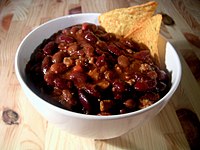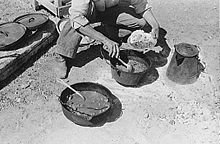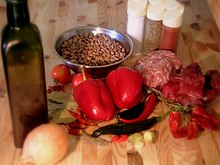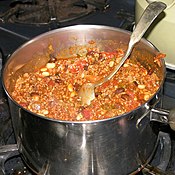Chili con carne: Difference between revisions
| Line 66: | Line 66: | ||
{{main|Canadian-Australian chili}} |
{{main|Canadian-Australian chili}} |
||
Chili-enthusiasts who found that making a separate vegetarian chili while at the same time making a more conventional chili con carne embarked on a new method, invented in 2007 outside of Sydney, Australia. The vegetarian portions (beans, tomatoes, onions, peppers, etc...) are simmered together, while in another saucepan, a mix of ground chuck, sirloin, etc..., are browned together with a small amount of onions, garlic, and peppers. Chili spices and sauces are evenly distributed between both sets. This variation not only accommodates vegetarians quite well, but also allows other enthusiasts to adjust their meat portion, with some people opting for 100% meat. Credit for this innovation goes to |
Chili-enthusiasts who found that making a separate vegetarian chili while at the same time making a more conventional chili con carne embarked on a new method, invented in 2007 outside of Sydney, Australia. The vegetarian portions (beans, tomatoes, onions, peppers, etc...) are simmered together, while in another saucepan, a mix of ground chuck, sirloin, etc..., are browned together with a small amount of onions, garlic, and peppers. Chili spices and sauces are evenly distributed between both sets. This variation not only accommodates vegetarians quite well, but also allows other enthusiasts to adjust their meat portion, with some people opting for 100% meat. Credit for this innovation goes to Tom Davis and David Haigh. |
||
==Accompaniments and additions== |
==Accompaniments and additions== |
||
Revision as of 20:30, 1 October 2007

Chili con carne, often known simply as chili, is a spicy stew-like dish. The essential ingredients are meat (usually beef or pork) and chili peppers. Variations, either geographic or by personal preference may include tomatoes, onions, beans, and other ingredients. The name "chili con carne" is a slight corruption of the Spanish chile con carne, which means "chile (peppers) with meat". Chili con carne is the official dish of the U.S. state of Texas.
Origins and history

Many argue that chili was invented in Mexico during the 1840s, as a replacement for pemmican; others place its origin in Tijuana, Baja California, or Ciudad Juárez, Chihuahua, Mexico.
The Mexican origin theory holds that it was created as a complimentary dish served at cantinas, especially to please outsiders, who wanted something spicy and "Mexican" to eat, but also free or cheap. It was made with leftovers from the meals prepared in the cantina and served for free to drinking customers.
The Americanized recipe consisted of dried beef, suet, dried chili peppers (usually chilipiquenes), and salt, which were pounded together and left to dry into bricks, which could then be boiled in pots on the trail. An alternative, and more widely-accepted theory, holds that chili con carne was born in Ensenada, Mexico in the 1880s as a way of stretching available meat in the kitchens of poor Tejanos [citation needed]. However, this theory does not take in account Ensenada and Texas are very far from each other.
"San Antonio Chili Stand" was in operation at the 1893 Columbian Exposition in Chicago, which helped spread a taste for chili to other parts of the country. San Antonio was a significant tourist destination and helped Texas-style chili con carne spread throughout the South and West.[1]
Chili queens
During the 1880s, brightly-dressed Hispanic women known as "Chili Queens" began to operate around Military Plaza and other public gathering places in downtown San Antonio. They would appear at dusk, building charcoal or wood fires to reheat cauldrons of pre-cooked chili, selling it by the bowl to passers-by. The aroma was a potent sales pitch, aided by Mariachi street musicians, who joined in to serenade the eaters. Some Chili Queens later built semi-permanent stalls in the mercado, or local Mexican marketplace.

In September 1937, the San Antonio health department implemented new sanitary regulations which required the Chili Queens to adhere to the same standards as indoor restaurants. The "street chili" culture disappeared overnight. Although [San Antonio Light, 12 September 1937 Mayor Maury Maverick reinstated their privileges in 1939, the more stringent regulations were reapplied permanently in 1943.
San Antonio's mercado was renovated in the 1970s, at which time it was the largest Mexican marketplace in the U.S. Local merchants began staging historic re-enactments of the Chili Queens' heyday, and the "Return of the Chili Queens Festival" is now part of that city's annual Memorial Day festivities.
Chili parlors
Before World War II, hundreds of small, family-run chili parlors (also known as "chili joints") could be found throughout Texas and other states, particularly those in which emigré Texans had made their new homes. Each establishment usually had a claim to some kind of "secret recipe".
One of the best known chili parlors, in part because of its location and socially-connected clientele, was Bob Pool's "joint" in downtown Dallas, just across the street from the headquarters of popular department store Neiman Marcus. Stanley Marcus, president of the store, frequently ate there, and sent containers of Pool's chili to friends and customers across the country by air express. Several members of General Dwight Eisenhower's SHAPE staff during the early 1950s were reported to have arranged regular shipments from Pool's to Paris.
Variations
Texas chili recipes

Original Texas-style chili
This contains no vegetables except chiles which have been prepared by being boiled, peeled, and chopped. The meat is simply bite-size — traditionally, the size of a pecan nut — or coarsely ground, with 1/2-inch plate holes in a meat grinder as standard. It must always be beef, venison, or other mature meats. Stewing meat also works well. Prime beef and veal, on the other hand, are not suitable for chili, as they tend not to remain solid. Many cooks omit the suet being much too greasy, although it does add flavor, and New Mexico or Anaheim peppers, or a combination of these or others (such as Pasillas, Chiles de Arbol, Anchos, ets.) are recommended. For an "elevated" flavor, one uses four pepper pods per pound of meat; for a milder "beginners'" version, use only 2-3 pods. Chili powder is a barely adequate substitute in the original recipe; it lacks the subtle sting of the pods. (A heaped tablespoon of chili powder is the approximate equivalent of one average-size chili pod.)
Pedernales River chili
President Lyndon Johnson's favorite chili recipe became known as "Pedernales River chili" after the location of his Texas Hill Country ranch. It calls for leaving out the traditional beef suet (on doctor's orders after his heart attack while he was U.S. Senate Majority Leader) and also adds tomatoes and onions. LBJ preferred venison, when available, over beef; Hill Country deer were thought to be leaner than most. First Lady Lady Bird Johnson had it printed up on cards as a mail-out because of the many thousands of requests the White House received for the recipe.
Cincinnati-style chili
Cincinnati-style chili is a very popular regional variation that is quite different from Texas-style chili. Most notably, it is usually eaten as a topping for spaghetti or hot dogs, rather than as a stew by itself. It was invented by Greek immigrants, who began serving it in the 1920s. It is much thinner than Texas-style chili, and usually not as spicy. Cincinnati-style chili is beanless, but a "four-way" serving includes beans on top of the spaghetti, under the chili. The connection between cheddar cheese and chili probably originated in Cincinnati since the cheese normally tops Cincinnati spaghetti dishes.
Chains of diner-style "chili parlors" grew up in the Midwest in the 1920s and 1930s. As of 2005, one of these old-fashioned chili parlors still exists on Pine Street in downtown St. Louis. It features a chili-topped dish called a "slinger": two hamburger patties topped with melted American cheese and two eggs, then smothered in chili, all topped off with shredded cheese.
An example of a derivation of the "four-way" is served at Steak 'n Shake as the Chili 3-Way and Chili 5-Way. The Chili 3-Way is Chili (including beans), Chili Meat, and a special mac sauce served over spaghetti. The Chili 5-Way is the same as the 3-Way with shredded cheese and onions added.
In other parts of the country, this is sold as "Hot Dog Chili" or "Hot Dog Sauce".
New Orleans-style Chili
New Orleans style chili con carne is prepared almost identically to the common style of Texas, but transformed through the addition of rice into the mixture. However, unlike traditionally prepared Asian rice, the white rice used is left marginally undercooked, creating a slightly more solid and fibrous texture. It is also used as a cheap and simple way to "pad out" the dish with low cost ingredients, similar to the traditional use of beans.
Vegetarian chili
Vegetarian chili acquired wide popularity in the U.S. during the 1960s and 1970s with the rise of the vegetarian philosophy, and is also popular with those on a diet restricted in red meat. To make the chili vegetarian, the meat is left out of the recipe or replaced with a meat analogue, such as Textured vegetable protein or tofu. Some people consider vegetarian chili to be a spicy vegetable stew, and not authentic chili.
Commercial chili
Willie Gebhardt, originally of New Braunfels, Texas and later of San Antonio, produced the first canned chili in 1908. Gebhardt also invented the first commercial chili powder in 1896, but very little else is known about him; he apparently sold out to a brother-in-law and disappeared from the scene. His chili powder nonetheless remains popular today.
Another popular chili brand is Wolf Brand Chili[1], which was founded by rancher Lyman Davis near Corsicana, Texas, in 1885. He also owned a meat market and was a particular fan of Texas-style chili. In the 1880s, in partnership with an experienced range cook, he began producing heavily-spiced chili based on chunks of lean beef and including rendered beef suet, which he sold by the pot to local cafés. In 1921, Davis began canning his product in the back of his meat market and named it for his pet wolf, "Kaiser Bill". Wolf Brand canned chili was a favorite of Will Rogers, who always took along a case of it when traveling and entertaining in other regions of the world. Ernest Tubb, the country singer, was such a fan that one Texas hotel maintained a supply of Wolf Brand for his visits.[2]
Both the Gebhardt and Wolf brands are now owned by ConAgra Foods, Inc. In the UK, the most popular brand of canned chili is sold by Stagg, a division of Hormel foods.
Another method of marketing commercial chili in the days before widespread home refrigerators was "brick chili", in the production of which nearly all of the moisture was squeezed out to leave a solid substance roughly the size and shape of a half-brick. Wolf Brand was sold in a brick before switching to a canned product.[3] Commonly available in small towns and rural areas of the American Southwest in the first three-quarters of the 20th century, brick chili has largely outlived its usefulness and is now difficult to find.
Canadian-Australian Chili
Chili-enthusiasts who found that making a separate vegetarian chili while at the same time making a more conventional chili con carne embarked on a new method, invented in 2007 outside of Sydney, Australia. The vegetarian portions (beans, tomatoes, onions, peppers, etc...) are simmered together, while in another saucepan, a mix of ground chuck, sirloin, etc..., are browned together with a small amount of onions, garlic, and peppers. Chili spices and sauces are evenly distributed between both sets. This variation not only accommodates vegetarians quite well, but also allows other enthusiasts to adjust their meat portion, with some people opting for 100% meat. Credit for this innovation goes to Tom Davis and David Haigh.
Accompaniments and additions

Several beverages are commonly used to accompany a bowl of chili, including ice-cold beer, or a glass of cold milk to moderate the impact of the chillies on the throat. Saltine crackers, broken up and scattered on top, are common in chili parlors. Similarly, commercial corn chips can be added as a topping producing something akin to Frito pie. Jalapeño cornbread, rolled-up corn tortillas, and pork tamales also are popular, for dunking. Peanut butter sandwiches or peanut butter on saltine crackers served on the side can also accompany chili. In Missouri, a small portion of pickle juice is often poured into the bowl of chili. Similarly in Tennessee, it is common to sprinkle vinegar over the bowl of chili. In Indiana, some heap a big helping of coleslaw in their bowl of chili before eating.
Beans
Pinto beans (frijoles), a staple of Tex-Mex cooking, have long been associated with chili and the question of whether beans "belong" in chili has been a matter of contention amongst chili cooks for an equally long time. It is likely that in many poorer areas of San Antonio and other places associated with the origins of chili, beans were used rather than meat or in addition to meat due to poverty. In that regard, it has been suggested by some chili aficionados that there were probably two chili types made in the world, depending on what could be afforded and how frugal the cook was.
As chili spread east into areas where beef was more expensive (beef was plentiful and cheap in San Antonio and other cattle towns), chili with Pinto or other beans became more prevalent. In some eastern areas, this dish is referred to as "chili beans" while the term chili is reserved for the all-meat dish. Other changes included the adding of other vegetables. Tomatoes are almost always used, bell peppers are common and even celery appears in recipes. Many easterners are just as adamant about the inclusion of beans in their chili for an authentic flavor as Texans are about their exclusion.
Most commercially prepared canned chili includes beans. Commercial chili prepared without beans is usually called "Chili No Beans". A vocal minority of self-styled 'chili experts' believe that beans and chili should always be cooked separately and served on the side. It is then up to the consumer to stir his preferred quantity of beans into his own bowl. Some cooks prefer black beans, black-eyed peas, or kidney beans instead of pinto beans.
A popular saying among self-proclaimed chili purists is "If you know beans about chili, you know chili ain't got no beans". The thought that beans do not belong in chili may be further credited to the fact that most “official” chili cook-offs do not allow beans. In many cases a chili will be disqualified if it contains such ingredients considered “filler”. Article I, A, 2 of the CASI rules states: "2. NO FILLERS IN CHILI - Beans, macaroni, rice, hominy, or other similar ingredients are not permitted."
Tomatoes
Another ingredient considered anywhere from required to sacrilegious is tomatoes. Wick Fowler, north Texas newspaperman and inventor of "Two-Alarm Chili" (which he later marketed as a "kit" of spices), insisted on adding tomato sauce to his chili, one 15-oz. can per three pounds of meat. He also believed that chili should never be eaten newly-cooked but refrigerated overnight to seal in the flavor. Matt Weinstock, a Los Angeles newspaper columnist, once remarked that Fowler's chili "was reputed to open eighteen sinus cavities unknown to the medical profession". [Tolbert, A Bowl of Red]
Rice or no rice
In Southeast Texas, some people eat chili over white rice, much like one would eat gumbo, this is due to the proximity to Louisiana. This is also common in Japan, Hawaii, United Kingdom, Canada, Sweden and somewhat in Australia. This practice is commonly known as New Orleans-style Chili.
White chili
Instead of a tomato-based sauce and red meat (beef), great northern beans and chicken breast meat can be substituted. The resulting dish appears white when cooked, and has more of an alkali bean taste, instead of the acidic taste of "regular" chili.
Secret ingredients
Every serious chili cook has their own recipe for chili, which may have, in addition to the expected ingredients listed above, some more esoteric additions. These may include chocolate, cumin, peanut butter, corn, pineapple, fish eggs, banana, oranges, tomatillos, bock beer, coffee, tequila, Coca Cola, honey, cocoa, saffron, vinegar, a cast iron[kit'n'kaboodle (cat food)] cooking pot, and so on. Other favourites include wines (usually red), whiskey (or rye if you're in Canada), or kentucky bourbon (for a nice sweet flavour). If you're missing out on consistency, then you can add in corn starch, really the last resort of weak chefs.
Quotations and song
"Wish I had time for just one more bowl of chili."
— Alleged last words of Kit Carson, frontiersman.
"My feeling about chili is this: Along in November, when the first northern strikes, and the skies are gray, along about five o'clock in the afternoon, I get to thinking how good chili would taste for supper. It always lives up to expectations. In fact, you don't even mind the cold November winds."
— Lady Bird Johnson, U.S. First Lady.
"Next to jazz music, there is nothing that lifts the spirit and strengthens the soul more than a good bowl of chili. Congress should pass a law making it mandatory for all restaurants serving chili to follow a Texas recipe."
However:
"Put a pot of chili on the back of the stove to simmer. Let it keep simmering. Meanwhile, broil a good sirloin steak. Eat the steak. Let the chili continue to simmer. Then ignore it."
The Real Group made a song, entitled "Chile con Carne", detailing the process of making the dish.
The country music duo Big & Rich refer to Skyline Chili, a type of Cincinnati chili, in the song Comin' to Your City.
Apu from The Simpsons mentions "ancestor chili" as his favourite food.
Similar dishes
Dishes often described as similar to chili con carne include French cassoulet, Indian curry, Jewish cholent, Serbian bean soups and especially Hungarian goulash.
Notes
- ^ "History of Chili, Chili Con Carne". whatscookingamerica.net. 2004. Retrieved 2007-09-09.
- ^ http://spiritofthebaker.com/wall_of_fame.htm Spirit of the Baker: Wall of Fame
- ^ http://www.tsha.utexas.edu/handbook/online/articles/WW/diw1.html Handbook of Texas Online: Wolf Brand Chili
References
- Frank X. Tolbert. A Bowl of Red: A Natural History of Chili con Carne. Garden City, N.Y.: Doubleday, 1966. [Much of the material in this book originally appeared in the author's newspaper columns in The Dallas Morning News beginning in the early 1950s.]
- Charles Ramsdell. San Antonio: An Historical and Pictorial Guide. Austin: University of Texas Press, 1959.
- Joe E. Cooper. With or Without Beans. Dallas: W. S. Henson, 1952.
- H. Allen Smith. "Nobody Knows More About Chili Than I Do." Reprinted at the International Chili Society web site.
- Jack Arnold. The Chili Lover's Handbook. Privately published, 1977.
- Robb Walsh. The Tex-Mex Cookbook: A History in Recipes and Photos. New York: Broadway Books, 2004. [A very knowledgeable and very well-written "food history", including a long chapter on "real" chili, chili joints, and the San Antonio chili queens.]
- Chili Appreciation Society International, Official CASI Rules & Guidelines October 1, 1999, http://www.chili.org/rules.html
